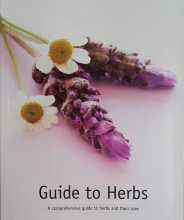
Herbs are very versatile plants. Their wonderful scents, colours and flavours have been used by generations of human beings for thousands of years in cooking and cosmetics and for dyeing fabrics. They have always been known for their healing properties. Even now, scientists are still discovering why some herbs are very potent healers.
This “Guide to Herbs” contains a wealth of information about more than 100 of the world’s most widely used herbs. With the help of superb colour photographs and useful fact-boxes, the reader can learn about the appearance, origins and habitat of each herb. Medicinal, culinary and cosmetic uses (both traditional and contemporary) of the herbs are also presented in the guide.
Botanists use the term “herb” to refer to a plant with a stem that is not woody, yet the term has taken on a larger meaning. An experienced cook would consider herb as a plant used to add flavour in cooking, such as basil. On the other hand, many people may consider herbs to be plants that are extensively used medicinally, such as aloe vera.
Mankind, however, has used herbs in many other diverse and ingenious ways: as insect repellents, for strewing on floors and scenting linen, for cosmetics and perfumery, for washing, preserving and in embalming.
Herbs range in size from low-growing plants through shrubs and creepers to trees. Mankind’s history of utilising herbs provides examples of every part of the plants being valuable: Leaves, stems, flowers, fruits, berries, seeds, roots, bulbs.
Throughout history, all around the globe different cultures have made use of the plants that grew wild around them, with herbs being a wonderful natural resource. Indian Ayurvedic medicine views health as being a harmony between body, mind and soul. This system of medicine uses herbs extensively. The valuable traditional knowledge gathered by the Rishis and practitioners of Ayurveda for centuries has been documented in many volumes such as “Charaka Samhite”, ‘Bhojana-kutoohalam” etc. China, too, has a long history of using herbs medicinally. A seminal textbook was Li Shizhen’s “Compendium of Materia Medica”, a 53-volume work compiled in 1578 during the Ming dynasty and still referred to today. In the West, much herbal knowledge was passed down from the ancient Greeks and Romans. In North America, the Native American tribes had an extensive knowledge of the healing properties of the plants around them and some European settlers drew upon this source of information.
In the Guide, over 100 magnificent herbs are arranged in alphabetical order by their Latin names, with detailed information. Overall, this comprehensively illustrated book provides a highly attractive, informative and practical guide to this fascinating subject.
